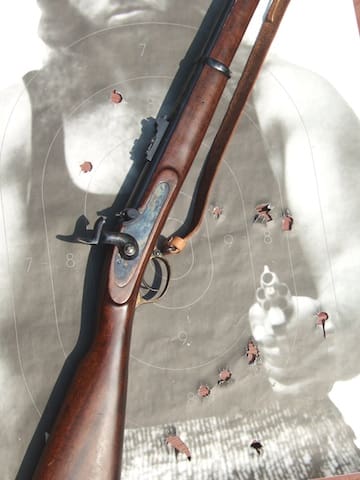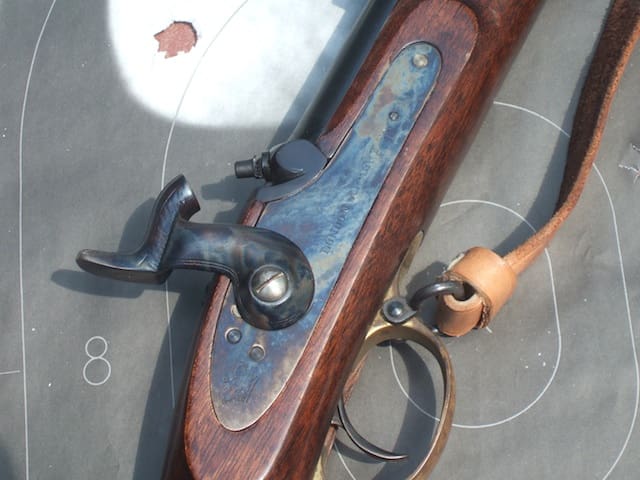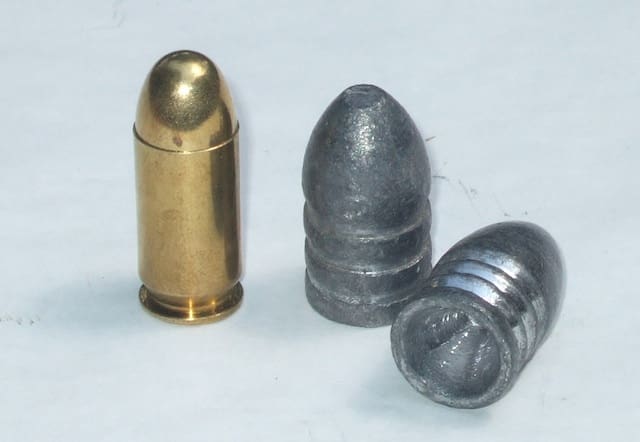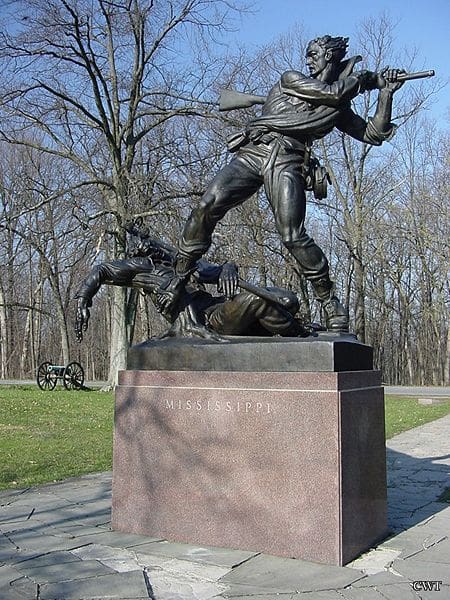One hundred and fifty years ago, my home state of Arkansas boiled with controversy. Before the bombardment of Fort Sumter on April 12, 1861, , the Arkansas state legislators voted to stay in the Union. After Fort Sumter, they voted to secede and join the Confederacy. As the comment thread following this TTAG post shows, 15 decades still hasn’t been enough time for the controversies and conflicts surrounding the Civil War (or the War of Northern Aggression, if you prefer) to cool completely. One thing that both Billy Yank and Johnny Reb agreed on: the Pattern 1853 Enfield rifled musket . . .
Union Private Henry A. Strong wrote of the day in Sept. 1862 when his unit exchanged their old Austrian Lorenz muskets for “Enfields Rifles, which are a splendid gun.” So what the heck is a “rifled musket?
Designed to fire the .577 minie ball, the 1853 Enfield was issued by the hundreds of thousands by both sides, and was often regarded as the most accurate mass-issued rifled musket of the war.
The NRA has an article about an 1853 Enfield carried and dropped at Gettysburg by Confederate infantryman J.A Fallin. In his diary, Union Private Henry A. Strong wrote of the day in Sept. 1862 when his unit exchanged their old Austrian Lorenz muskets for
usket?” Why didn’t they just call it a rifle or a musket? This type of weapon was termed a rifled musket because it loaded from the muzzle like the old smoothbore muskets, yet featured spiral grooves cut into the bore that made the projectile spin, hence “rifled.”
It was the projectile that made the rifled musket revolutionary. Named the “minie ball” after its French military developer Claude Minie, this sub-caliber, conical lead bullet with a hollow base allowed troops to load their guns as rapidly as old-fashioned smoothbore muskets, but shoot with the accuracy of old-fashioned rifles.
The old-school rifles used patched round balls that tightly fit the bore, and after only a few shots, they became impossible to reload until somebody swabbed out the fouling—not an easy task while folks are shooting at you or charging at you with fixed bayonets. Because the minie ball had a diameter smaller than the bore, it dropped slickly down clean barrels, and could be easily rammed down barrels fouled with black powder residue from many previous shots.
When the powder charge behind the minie ball’s hollow base exploded, the hot gases forced the minie ball’s lead skirt to flare out and engage the rifling, creating a stabilizing spin. This spin made rifled muskets considerably more accurate over much longer distances than smoothbore muskets.
Unfortunately, neither the Union nor Confederate officer corps could easily put aside the Napoleonic tactics they learned at West Point, predicated on the relatively short range and inaccuracy of the old smoothbores. Adherence to these outdated tactics contributed to shockingly high casualties in battle after battle with the rifled muskets.
With an 1853 Enfield, skilled riflemen could hit man-sized targets at 500 yards. I have repeatedly hit a six-foot by two-foot target at 300 yards with my Euro Arms copy, and would love to find a range long enough for me to stretch it out even farther.
I can only imagine how terrifying it must have been to stand in front of a rank of hundreds of men shooting rifled muskets at me–even more so when I think that .577 caliber minie balls bring at least 500 grains of pure soft-lead hurt when they hit home. Some of the minie balls I shoot weight 575 grains. In contrast, the classic .45 ACP FMJ bullet weighs in at a measly 230 grains, or about half as much. And the Enfield launches its projectile at just under 1000 feet per second.
The soft lead construction and large diameter and weight of the minie ball helped account for the high number of amputations during the Civil War. When a lead slug that big and heavy hit an arm or a leg bone, the resulting splintery, pulpy mess was so devastated that even today’s medicine would have few options beyond amputation.
[HTML1]
Loading and shooting my ‘53 Enfield gives me shivery appreciation for the cojones it took to stand and exchange volley after volley of rifled musket fire across smokey fields littered with dead and wounded. And stand you would, because it’s damned hard to pour 70 grains of black powder down the muzzle of an Enfield if you’re lying on the ground, or trying to crouch behind cover.
The rifled musket’s sheer size makes taking cover a bit of a challenge. My ‘53 Enfield stands a fraction over four foot seven, from brass buttplate to muzzle. That’s only two inches short of being able to ride in my truck without a booster seat. That’s almost a foot taller than Herve Villechaize. It weighs 9 pounds, and when tipped with the 21-inch-long socket bayonet that I don’t own yet, it would make a formidable spear and a nasty club.
It’s not for nothing that the Mississippi troop monument at Gettysburg shows a Confederate soldier grasping his rifled musket by the barrel and swinging for the fences atop Cemetary Ridge.
Even though it’s long and heavy and slow to load, I love shooting my 1853 Enfield. With minie balls, it splatters jugs of water most satisfactorily. I once stapled up a life-sized bad guy target at 100 yards and fired 11 shots at it as rapidly as I could load and find the front sight somewhere on the target. It produced 11 hits, any one of which would have been completely disabling on any Civil War battlefield.
I have taken it into the deer woods a couple of times during muzzleloader season, but I’ve yet to see a deer while toting my Enfield. Like any other black powder arm, it spews billowy clouds of fragrant smoke, spits tongues of flame and speaks with that classic deep, dull BOOOM! And it gives me just a little sense of what it might have been like to have been a Civil War soldier when I hold one in my hands and look down its sights at a target.








Nice article!
Extremely cool.
Great article on Civil War firearms and thanks for providing info on a point I made on the 45 ACP vs the 40 cal or 9mm. Your comment on the wound produced by a slow soft lead large caliber round documents why the 45 ACP is the most lethal round available outside of a 44 magnum. Mass is always more important then velocity when it comes to lethality.
Let’s not start that again…
Please do. I have access to the military lethality data. Do you?
Great article Roy. That video was awesome, gave me a big ole grin when you pulled the trigger. Definitely gonna have to start looking into one of those.
Don’t forget the bayonet!
Roy,
Great video. Your article was also fun to read and very interesting. Keep it up. I agree with you about the lack of cover during reloading. I cannot fathom how Solomon Wilson survived Shiloh with these issues. Great article.
Wonderful article! Quick fact, the Civil War did produce the first known snipers in modern warfare (believe it or not, the Civil War is considered modern). Skilled rifleman would take rifled muskets to the edges of major battles and pick off soldiers and officers. Believe it or not, it is believed that an assassination plot against President Lincoln that never got off paper involved a long range shot. (This is separate from the 1864 attempt that involved a close range shot that shot Lincoln’s iconic hat off)
Major General Reynolds was taken out by a sniper at Gettysburg.
“Major General Reynolds was taken out by a sniper at Gettysburg.”
Debatable.
There were at least 5-6 Confederate veterans who each claimed to have shot Reynolds. Popular consensus by historians is that he was likely hit by a stray ball as opposed to a well-aimed shot, despite the fact that he was shot in the back of the head.
The excellent film “Gettysburg” does show a sharpshooter take aim and take Reynolds down, which no doubt has led many to believe that it is what actually happened.
Thanks Ben Eli.
The Civil War did have”snipers” albeit they were typically called sharpshooters. They were employed to great effect by both Union and Confederate armies.
Google “General John Sedgwick” for the all-time example of perfectly bad timing when it comes to instilling confidence in your troops with sharpshooters nearby.
Check out this book for a great read on the US Sharpshooters.
http://www.amazon.com/Sharpshooter-Berdan-Famous-Sharpshooters-Sharps/dp/091721837X
Finally, as an old Southern boy, I’ve had a long time hankerin’ to get my paws on one of these gems.
http://johno.myiglou.com/whitworth.htm
Looks a lot like an 1853 Enfield on the outside, but the specialized rifling and freaky ammo really made it a whole different critter.
Thanks for the reads.
The Whitworth is an amazing firearm. Outfit it with one of those full barrel length scopes, and you got a lean mean Yankee-killing machine.
Cool video!
Funny, I was just out in the garage casting minie balls for my 1862 2-band Springfield. I skirmish in the N-SSA, and our nationals is this week. I use a .575 315 grain wadcutter, different than the traditional minie ball which weighs around 500 grains if I recall correctly. We go with lighter since we’re shooting competitively.
Personally, I’m not a big fan of the Enfields because of the straight stock, I prefer the slight bend of the Springfield. Enfields are great guns though, and they look great too.
I found with my Enfield that the first two shots from a clean barrel are a bit wild, but then it settles down and shoots consistently. It works very well on whitetails.
I would’ve certainly thought more than 900 fps. Excellent article.
The ’53 Enfield is not a “rifled musket”. A “rifled musket” is a gun manufactured as a “musket”, and later had the barrel “rifled” to modernize it. The Enfield is a “rifle musket”, which is to say, a long, light barreled service rifle resembling a musket. A “rifle” has a shorter, heavier barrel than the “musket” or “rifle musket”.
JL
The term rifled musket or rifle musket refers to a specific type of weapon made in the mid-19th century. Originally the term referred only to muskets that had been produced as a smoothbore weapon and later had their barrels rifled. The term was later extended to include rifles that directly replaced, and were of the same design overall, as a particular model smooth bore musket.
Hey Roy, thanks for this article and the video! I do not own guns, I am merely a Civil War enthusiast who found this site after re-watching the PBS Civil War series by Ken Burns. In that documentary, Shelby Foote reveals just how lethal this weapon was to soldiers of the time: shattered bones, obliterated internal organs. The soldiers had to have been aware of this as well, so I thought it was really cool of you to acknowledge the bravery required to stand upright in a field and exchange multiple volleys with other men who were aiming to kill. It was also really interesting and inspiring to watch an old weapon fire effectively. I guess they don’t make ’em like they used to! Thanks again.
Enjoyed your article. The picture of the musket that was left behind by the Confederate soldier shows the number 24 twice on the barrel, meaning a bore size of .58 cal. Not uncommon with imports. Most would have the number 25 which means a .577 bore. Mine is extremely accurate also with 40gr of FF and a 500gr minie.
Hmm it looks like yopur website ate my first comment (it was extremely long)
so I guess I’ll just sum it up what I wrote and say, I’m thoroughly enjoying your blog.
I too am an aspiring blog writer butt I’m still new
to everything. Do yoou have any helpful hints for novice blog
writers? I’d certainly aappreciate it.
I have read articles about how for the most part, modern law enforcement people are poorly trained as shooters, and often miss, even at fairly close range. When I read the comment:
“With an 1853 Enfield, skilled riflemen could hit man-sized targets at 500 yards.” maybe, but I am incredulous. Certainly there would be very few guys who could shoot that well.
More thorough research indicates that the high casualties were due to the fact that no one had any tactical training. Imagine if the South had used these sorts of tactics at Gettysburg. One problem was the sheer weight and bulky nature of these rifles; you’re a sitting duck while reloading. Would have made it much harder to practice these sorts of SAS tactics. How much do did these things weigh?
Actually there is no conflict to cool. Some people simply wish to reimagine history or ignore it completely. We are the United States of America. Not the U.S.A. and C.S.A- The United States of America. The debate was settled on April 9, 1865 .
I realize you were just being nonpartisan in your writing still the obvious has to be pointed out for some.
Comments are closed.